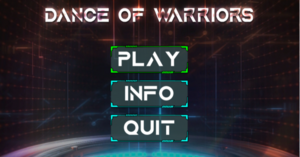
This project aims to create a 3D fighting game in the Unity 3D game engine with fighting mechanics that invoke the feeling of dancing with the player’s opponent. This project idea takes influence from other games with at least some similar fighting mechanics, such as: Dark Souls, The Witcher 3, and Monster Hunter.
Many games have boss fights; They have been a staple of video games since arcade games. Boss fights are generally fights at the end of a level in which the enemy being fought is stronger, larger, has more health, faster, or any varying combinations of abilities that make the enemy a powerful foe. Some bosses attack in predictable patterns that are telegraphed at the beginning of their attack, and some of these bosses attack with a particular rhythm. The player, usually too weak to simply take the full force of the attack, then has to move, block, deflect, or perform some other moves in time with the bosses’ attacks in order to minimize the damage taken. Bosses of this type will often then hesitate before attacking again in order to allow the player to attack them and deal some damage.
This relationship, communication, and mutual respect between the player and the enemy is reminiscent of the relationship of two dancers. However, there are not many games that emphasize this relationship, or explore it in detail. We aim to change this by building a combat system that evokes feelings similar to those evoked while dancing.
To accomplish this, the game focuses on the idea of music rhythms, specifically seperating a given song into its respective beats allowing actions to be triggered on beat, such as enemy attacks and environment changes, allowing for a semi-managed interaction where both characters can get into a rhythm, mimicking a dance. However, building off of this, the project also illustrates a variety of aspects such as limb damage, combat systems, inventory, varying movement options, and multiple input options.
The limb damage mechanic is designed to help the player feel more involved during gameplay. Limb damage has effects like slowing the player down or causing them to deal less damage to their opponent. This mechanic was included to give an extra consequence to the player taking damage and to give the player strategic options against the enemy. Slowing the player down will present extra dangers and force a more cautious play-style, and causing the player to deal less damage will lengthen the duration of the fight.
The player character has a variety of movement options such as running, sprinting, jumping, and dodging. Each of these movement options serve the purpose of allowing the player to interact with their opponent in a variety of ways. In addition to this, the user has the option of either using a controller or a mouse and keyboard to interact with the game. Additionally, the user can adjust their look sensitivity to their liking in the main menu.
Combat systems within the game include several different attacks that each character is able to perform while fighting their opponent. There are currently two different weapons to be used by the player character, and just one for the enemy. The player can use a sword and a gun to fight their enemy, while the boss only has a sword. This is balanced by damage scale. The sword has both a light and a heavy attack, while the gun has a regular “shooting” attack and a short punch.
The inventory system is used within the game to assist with future implementations of picking up and dropping weapons. Right now, it is used with healing items. There are two different healing items within the game: A health pack and a Doctor’s bag. The health pack heals the player’s overall health (not their limb health), while the Doctor’s bag heals the player’s limbs (not their character’s health). The inventory system is made to be built upon and improved in the future.
Project Team Member Emails:
Markwelc@oregonstate.edu
Koffela@oregonstate.edu
Tremperb@oregonstate.edu
Hartwelg@oregonstate.edu
| Attachment | Size |
|---|---|
| 609.14 KB | |
| 2.35 MB |

